Optimizing Management of the Qinling–Daba Mountain Area Based on Multi-Scale Ecosystem Service Supply and Demand
Abstract
:1. Introduction
2. Study Area and Methods
2.1. Study Area
2.2. Data Sources
2.3. Supply and Demand Assessment of ESs
2.4. Supply–Demand Ratio of ESs
2.5. Driver Analysis
2.6. Methodological Framework
3. Results
3.1. Supply and Demand Assessment of Ecosystem Services
3.2. Interactions between ES Supply and Demand at Different Scales
3.2.1. Analysis of Ecosystem Service Tradeoffs
3.2.2. Ratio of Supply and Demand for Ecosystem Services
3.3. Identification of Hotspots
3.4. Analysis of Driving Factors
4. Discussion
4.1. Scale Effects on the Distribution of ES Supply and Demand
4.2. Drivers of Ecosystem Services
4.3. Optimization of Ecological Space Based on Supply and Demand of Ecosystem Services
4.4. Uncertainties and Limitations
5. Conclusions
Author Contributions
Funding
Data Availability Statement
Conflicts of Interest
Appendix A
A.1. Supply and Demand Assessment of ESs
A.1.1. Water Yield
A.1.2. Habitat Quality
A.1.3. Landscape Aesthetics
A.1.4. Soil Conservation
A.1.5. Net Primary Productivity
References
- Burkhard, B.; Kroll, F.; Nedkov, S.; Müller, F. Mapping ecosystem service supply, demand and budgets. Ecol. Indic. 2012, 21, 12–29. [Google Scholar] [CrossRef]
- Ma, L.; Liu, H.; Peng, J.; Wu, J.-S. A review of ecosystem services supply and demand. Acta Geogr. Sin. 2017, 72, 1277–1289. [Google Scholar] [CrossRef]
- Wang, J.; Zhai, T.-L.; Lin, Y.-F.; Kong, X.-S.; He, T. Spatial imbalance and changes in supply and demand of ecosystem services in China. Sci. Total Environ. 2019, 657, 781–791. [Google Scholar] [CrossRef] [PubMed]
- Zhang, L.-W.; Fu, B.-J. The progress in ecosystem services mapping: A review. Acta Ecol. Sin. 2014, 35, 316–325. [Google Scholar] [CrossRef]
- Costanza, R.; de Groot, R.; Sutton, P.; van der Ploeg, S.; Anderson, S.-J.; Kubiszewski, I.; Farber, S.; Turner, R.-K. Changes in the global value of ecosystem services. Glob. Environ. Chang. 2014, 26, 152–158. [Google Scholar] [CrossRef]
- Jiang, B.; Bai, Y.; Chen, J.-Y.; Alatalo, J.-M.; Xu, X.-B.; Liu, G.; Wang, Q. Land management to reconcile ecosystem services supply and demand mismatches-A case study in Shanghai municipality, China. Land Degrad. Dev. 2020, 31, 2684–2699. [Google Scholar] [CrossRef]
- Owuor, M.-A.; Icely, J.; Newton, A.; Nyunja, J.; Otieno, P.; Tuda, A.-O.; Oduor, N. Mapping of ecosystem services flow in Mida Creek, Kenya. Ocean. Coast. Manag. 2017, 140, 11–21. [Google Scholar] [CrossRef]
- De Groot, R.-S.; Wilson, M.-A.; Boumans, R.-M.-J. A typology for the classification, description and valuation of ecosystem functions, goods and services. Ecol. Econ. 2002, 41, 393–408. [Google Scholar] [CrossRef]
- Liu, Y.; Bi, J.; Lv, J.-S.; Ma, Z.-W.; Wang, C. Spatial multi-scale relationships of ecosystem services: A case study using a geostatistical methodology. Sci. Rep. 2017, 7, 9486. [Google Scholar] [CrossRef]
- Geijzendorffer, I.-R.; Martín-López, B.; Roche, P.-K. Improving the identification of mismatches in ecosystem services assessments. Ecol. Indic. 2015, 52, 320–331. [Google Scholar] [CrossRef]
- Jaligot, R.; Chenal, J.; Bosch, M. Assessing spatial temporal patterns of ecosystem services in Switzerland. Landsc. Ecol. 2019, 34, 1379–1394. [Google Scholar] [CrossRef]
- Zhang, G.-S.; Zheng, D.; Xie, L.; Zhang, X.; Wu, H.-J.; Li, S. Mapping changes in the value of ecosystem services in the Yangtze River Middle Reaches Megalopolis, China. Ecosyst. Serv. 2021, 48, 101252. [Google Scholar] [CrossRef]
- Turner, K.-G.; Odgaard, M.-V.; Bocher, P.-K.; Dalgaard, T.; Svenning, J.-C. Bundling ecosystem services in Denmark: Trade-offs and synergies in a cultural landscape. Landsc. Urban Plan. 2014, 125, 89–104. [Google Scholar] [CrossRef]
- Zwierzchowska, I.; Hof, A.; Iojă, I.-C.; Mueller, C.; Poniży, L.; Breuste, J.; Mizgajski, A. Multi-scale assessment of cultural ecosystem services of parks in Central European cities. Urban For. Urban Green. 2018, 30, 84–97. [Google Scholar] [CrossRef]
- Ciftcioglu, G.-C. The social valuation of agro-ecosystem services at different scales: A case study from Kyrenia (Girne) Region of Northern Cyprus. Environ. Dev. 2021, 39, 100645. [Google Scholar] [CrossRef]
- Xu, S.-N.; Liu, Y.-F.; Wang, X.; Zhang, G.-X. Scale effect on spatial patterns of ecosystem services and associations among them in semi-arid area: A case study in Ningxia Hui Autonomous Region, China. Sci. Total Environ. 2017, 598, 297–306. [Google Scholar] [CrossRef]
- Raudsepp-Hearne, C.; Peterson, G.-D. Scale and ecosystem services: How do observation, management, and analysis shift with scale- lessons from Québec. Ecol. Soc. 2016, 21, 16. [Google Scholar] [CrossRef]
- Roces-Díaz, J.-V.; Vayreda, J.; Banqué-Casanovas, M.; Díaz-Varela, E.; Bonet, J.-A.; Brotons, L.; de-Miguel, S.; Herrando, S.; Martínez-Vilalta, J. The spatial level of analysis affects the patterns of forest ecosystem services supply and their relationships. Sci. Total Environ. 2018, 626, 1270. [Google Scholar] [CrossRef]
- Wei, H.-J.; Fan, W.-G.; Wang, X.-C.; Lu, N.-C.; Dong, X.-B.; Zhao, Y.-N.; Ya, X.-J.; Zhao, Y.-F. Integrating supply and social demand in ecosystem services assessment: A review. Ecosyst. Serv. 2017, 25, 15–27. [Google Scholar] [CrossRef]
- Wu, X.; Liu, S.-L.; Zhao, S.; Hou, X.-Y.; Xu, J.-W.; Dong, S.-K.; Liu, G.-H. Quantification and driving force analysis of ecosystem services supply, demand and balance in China. Sci. Total Environ. 2019, 652, 1375–1386. [Google Scholar] [CrossRef]
- Alamgir, M.; Turton, S.-M.; Macgregor, C.-J.; Pert, L.-P. Assessing regulating and provisioning ecosystem services in a contrasting tropical forest landscape. Ecol. Indic. 2016, 64, 319–334. [Google Scholar] [CrossRef]
- Serna-Chavez, H.-M.; Kissling, W.-D.; Veen, L.-E.; Swenson, N.-G.; van Bodegom, P.-M. Spatial scale dependence of factors driving climate regulation services in the Americas. Glob. Ecol. Biogeogr. 2018, 27, 828–838. [Google Scholar] [CrossRef]
- Ouyang, Z.-Y.; Zheng, H.-W.; Xiao, Y.; Stephen, P.; Liu, J.-G.; Xu, W.-H.; Wang, Q.; Zhang, L.; Rao, E.-M.; Jiang, L.; et al. Improvements in ecosystem services from investments in natural capital. Science 2016, 352, 1455–1459. [Google Scholar] [CrossRef]
- Song, W.; Deng, X.-Z. Land-use/land-cover change and ecosystem service provision in China. Sci. Total Environ. 2017, 576, 705–719. [Google Scholar] [CrossRef] [PubMed]
- Filho, W.-L.; Barbir, J.; Sima, M.; Kalbus, A.; Nagy, G.-J.; Paletta, A.; Villamizar, A.; Martinez, R.; Azeiteiro, U.-M.; Pereira, M.-J.; et al. Reviewing the role of ecosystems services in the sustainability of the urban environment: A multi-country analysis. J. Clean. Prod. 2020, 262, 121338. [Google Scholar] [CrossRef]
- Fang, L.-L.; Wang, L.-C.; Chen, W.-X.; Sun, J.; Cao, Q.; Wang, S.-Q.; Wang, L.-Z. Identifying the impacts of natural and human factors on ecosystem service in the Yangtze and Yellow River Basins. J. Clean. Prod. 2021, 314, 127995. [Google Scholar] [CrossRef]
- Tang, X.-J.; Chen, X.-X. Thoughts on the paths of cross-regional ecological environmental governance in Qinling-Dabashan Mountainous area. J. Southwest Pet. Univ. 2019, 21, 28–34. [Google Scholar]
- Liu, L.-C.; Liu, C.F.; Wang, C.; Li, P.-J. Supply and demand matching of ecosystem services in loess hilly region: A case study of Lanzhou. Acta Geogr. Sin. 2019, 74, 1921–1937. [Google Scholar]
- Yan, Y.; Zhu, J.-Y.; Wu, G.; Zhan, Y.-J. Review and prospective applications of demand, supply, and consumption of ecosystem services. Acta Ecol. Sin. 2017, 37, 2489–2496. [Google Scholar]
- Han, C.-J.; Wang, G.-G.; Yang, Y.-P. An assessment of sustainable wellbeing and coordination of mountain areas: A case study of Qinba Mountain Area in China. Ecol. Indic. 2023, 154, 110674. [Google Scholar] [CrossRef]
- Liu, J.-J.; Zhang, B.-P.; Yao, Y.-H.; Zhang, X.-H.; Wang, J.; Yu, F.-Q.; Li, J.-Y. Latitudinal differentiation and patterns of temperate and subtropical plants in the Qinling-Daba Mountains. J. Geogr. Sci. 2023, 33, 907–923. [Google Scholar] [CrossRef]
- Chen, D.-S.; Li, J.; Yang, X.-N.; Zhou, Z.-X.; Pan, Y.-Q.; Li, M.-C. Quantifying water provision service supply, demand and spatial flow for land use optimization: A case study in the YanHe watershed. Ecosyst. Serv. 2020, 43, 101117. [Google Scholar] [CrossRef]
- Zhang, C.; Li, J.; Zhou, Z.-X.; Sun, Y.-J. Application of ecosystem service flows model in water security assessment: A case study in Weihe River Basin, China. Ecol. Indic. 2021, 120, 106974. [Google Scholar] [CrossRef]
- Wang, B.Y.; Oguchi, T.; Liang, X. Evaluating future habitat quality responding to land use change under different city compaction scenarios in Southern China. Cities 2023, 140, 104410. [Google Scholar] [CrossRef]
- Swetnam, R.-D.; Harrison-Curran, S.-K.; Smith, G.-R. Quantifying visual landscape quality in rural Wales: A GIS-enabled method for extensive monitoring of a valued cultural ecosystem service. Ecosyst. Serv. 2017, 26, 451–464. [Google Scholar] [CrossRef]
- Cui, F.-Q.; Tang, H.-Q.; Zhang, Q.; Wang, B.-J.; Dai, L.-W. Integrating ecosystem services supply and demand into optimized management at different scales: A case study in Hulunbuir, China. Ecosyst. Serv. 2019, 39, 100984. [Google Scholar] [CrossRef]
- Rao, W.-G.; Shen, Z.-H.; Duan, X.-W. Spatiotemporal patterns and drivers of soil erosion in Yunnan, Southwest China: RULSE assessments for recent 30 years and future predictions based on CMIP6. CATENA 2023, 220, 106703. [Google Scholar] [CrossRef]
- Wischmeier, W.H.; Mannering, J.V. Relation of soil properties to its erodibility. Soil Sci. Soc. Am. J. 1969, 33, 131–137. [Google Scholar] [CrossRef]
- Wischmeier, W.-H.; Smith, D.-D. Predicting precipitation fall erosion losses-A guide to conservation planning. Agric. Handb. 1978, 537, 285–291. [Google Scholar]
- Mccool, D.-K.; Brown, L.-C.; Foster, G.-R.; Mutchler, C.-K. Revised Slope Steepness Factor for the Universal Soil Loss Equation. Trans. ASAE Am. Soc. Agric. Eng. 1987, 30, 1387–1396. [Google Scholar] [CrossRef]
- Cai, C.F.; Ding, S.W.; Shi, Z.H.; Huang, L.; Zhan, G.Y. Study of applying USLE and geographical information system IDRISI to predict soil erosion in small watershed. J. Soil Water Conserv. 2000, 14, 19–24. [Google Scholar]
- Potter, C.-S.; Randerson, J.-T.; Field, C.-B.; Matson, P.-A.; Vitousek, P.-M.; Mooney, H.-A.; Klooster, S. Terrestrial ecosystem production: A process model based on global satellite and surface data. Glob. Biochem. Cycle 1993, 7, 811–841. [Google Scholar] [CrossRef]
- Li, T.; Li, J.; Wang, Y.-Z. Carbon sequestration service flow in the Guanzhong-Tianshui economic region of China: How it flows, what drives it, and where could be optimized? Ecol. Indic. 2019, 96 Pt 1, 548–558. [Google Scholar] [CrossRef]
- Yu, Y.-Y.; Li, J.; Zhou, Z.-X.; Zeng, L.; Zhang, C. Estimation of the Value of Ecosystem Carbon Sequestration Services under Different Scenarios in the Central China (the Qinling-Daba Mountain Area). Sustainability 2020, 12, 337. [Google Scholar] [CrossRef]
- Wang, J.-F.; Xu, C.-D. Geodetector: Principle and prospective. Acta Geogr. Sin. 2017, 72, 116–134. [Google Scholar]
- Wang, J.-F.; Li, X.-H.; Christakos, G.; Liao, Y.-L.; Zhang, T.; Gu, X.; Zheng, X.-Y. Geographical Detectors-Based Health Risk Assessment and its Application in the Neural Tube Defects Study of the Heshun Region, China. Int. J. Geogr. Inf. Sci. 2010, 24, 107–127. [Google Scholar] [CrossRef]
- Wu, W.-H.; Peng, J.; Liu, Y.X.; Hu, Y.-N. Tradeoffs and synergies between ecosystem services in Ordos City. Prog. Geogr. 2017, 36, 1571–1581. [Google Scholar]
- Wang, X.-F.; Fu, X.-X.; Chu, B.-Y.; Li, Y.-H.; Yan, Y.; Feng, X.-M. Spatiotemporal variation of water yield and its driving factors in Qinling Mountains barrier region. J. Nat. Resour. 2021, 36, 2507–2521. [Google Scholar]
- Wang, X.-Z.; Wu, J.-Z.; Liu, Y.-L.; Hai, X.-Y.; Shangguan, Z.-P.; Deng, L. Driving factors of ecosystem services and their spatiotemporal change assessment based on land use types in the Loess Plateau. J. Environ. Manag. 2022, 311, 114835. [Google Scholar] [CrossRef] [PubMed]
- Li, J.-Y.; Geneletti, D.; Wang, H.-C. Understanding supply-demand mismatches in ecosystem services and interactive effects of drivers to support spatial planning in Tianjin metropolis, China. Sci. Total Environ. 2023, 895, 165067. [Google Scholar] [CrossRef]
- Shen, J.-S.; Li, S.-C.; Wang, H.; Wu, S.-Y.; Liang, Z.; Zhang, Y.-T.; Wei, F.-L.; Li, S.; Ma, L.; Wang, Y.-Y.; et al. Understanding the spatial relationships and drivers of ecosystem service supply-demand mismatches towards spatially targeted management of social-ecological system. J. Clean. Prod. 2023, 406, 136882. [Google Scholar] [CrossRef]
- Wang, G.-C.; Li, Z.-C. The valuation of ecosystem services based on temporal, spatial and benefit characters. Acta Ecol. Sin. 2007, 27, 4758–4765. [Google Scholar]
- Luo, G.-P.; Zhang, A.-J.; Yin, C.-Y.; Lu, L. Progress and prospects of multi-scale evaluation of land change. Arid. Zone Res. 2009, 26, 41–47. [Google Scholar] [CrossRef]
- Zhang, Y.-S.; Wu, D.-T.; Lv, X. A review on the impact of land use/land cover change on ecosystem services from a spatial scale perspective. J. Nat. Resour. 2020, 35, 1172–1189. [Google Scholar]
- Zhang, Y.-M.; Zhao, S.-D. Contributions and lessons of multiscale assessments. Adv. Earth Sci. 2007, 22, 851–856. [Google Scholar] [CrossRef]
- Rodríguez, J.-P.; Douglas, B.-T.; Bennett, E.-M.; Cumming, G.-S. Trade-offs across Space, Time, and Ecosystem Services. Ecol. Soc. 2005, 11, 709–723. [Google Scholar] [CrossRef]
- Seppelt, R.; Fath, B.; Burkhard, B.; Fisher, J.; Grêt-Regamey, A.; Lautenbach, S.; Pert, P.; Hotes, S.; Spangenberg, J.; Verburg, P.-H.; et al. Form follows function? Proposing a blueprint for ecosystem service assessments based on reviews and case studies. Ecol. Indic. 2012, 21, 145–154. [Google Scholar] [CrossRef]
- Li, P.; Jiang, L.G.; Feng, Z.-M.; Yu, X.-B. Research progression trade-offs and synergies of ecosystem services: An overview. Acta Ecol. Sin. 2012, 32, 5219–5229. [Google Scholar]
- Bohensky, E.-L.; Reyers, B.; Van Jaarsveld, A.-S. Future ecosystem services in a Southern African river basin: A scenario planning approach to uncertainty. Conserv. Biol. 2006, 20, 1051–1061. [Google Scholar] [CrossRef]
- Zhang, Z.-H.; Nie, T.-T.; Gao, Y.; Sun, S.-M.; Gao, J. Study on temporal and spatial characteristics of coupling coordination correlation between ecosystem services and economic-social development in the Yangtze River Economic Belt. Resour. Environ. Yangtze Basin 2022, 31, 1086–1100. [Google Scholar]
- Gao, M.; Xiao, Y.; Hu, Y.-F. Evaluation of water yield and soil erosion in the Three-River-Source region under different land-climate scenarios. J. Resour. Ecol. 2020, 11, 13–26. [Google Scholar]
- Liu, S.-C.; Shao, Q.-Q.; Niu, L.-N.; Ning, J.; Liu, G.-B.; Zhang, X.-Y.; Huang, H.-B. Changes of ecological and the characteristics of trade-offs and synergies of ecosystem services in the upper reaches of the Yangtze River. Acta Ecol. Sin. 2023, 43, 1028–1039. [Google Scholar]
- Wang, P.-T.; Zhang, L.-W.; Li, Y.-J.; Jiao, L.; Wang, H.; Yan, J.-P.; Lv, Y.-H.; Fu, B.-J. Spatio-temporal characteristics of the trade-off and synergy relationships among multiple ecosystem services in the Upper Reaches of Hanjiang River Basin. Acta Geogr. Sin. 2017, 72, 2064–2078. [Google Scholar]
- Niu, Z.-E.; He, H.-L.; Ren, X.-L.; Zhang, L.; Qin, K.-Y.; Zhao, D.; Lv, Y. Spatio-temporal characteristic of terrestrial ecosystem services and their tradeoffs and synergies in China from 2000 to 2018 based on a process model. Acta Ecol. Sin. 2023, 43, 496–509. [Google Scholar]
- Sannigrahi, S.; Zhang, Q.; Pilla, F.; Joshi, P.-K.; Basu, B.; Keesstra, S.; Roy, P.-S.; Wang, Y.; Sutton, P.-C.; Chakraborti, S.; et al. Responses of ecosystem services to natural and anthropogenic forcings: A spatial regression based assessment in the world’s largest mangrove ecosystem. Sci. Total Environ. 2020, 715, 137004. [Google Scholar] [CrossRef] [PubMed]
- Zhang, J.; Lei, G.; Qi, L.-H. Temporal and Spatial Dynamics and Scenario Simulation of Water Yield in Danjiangkou Reservoir Area. Sci. Silvae Sin. 2020, 56, 12–20. [Google Scholar]
- Sun, X.-Y.; Shan, R.-F.; Liu, F. Spatio-temporal quantification of patterns, trade-offs and synergies among multiple hydrological ecosystem services in different topographic basins. J. Clean. Prod. 2020, 268, 122338. [Google Scholar] [CrossRef]
- Wang, T.; Zhao, Y.-T.; Xu, C.-Y.; Ciais, P.; Liu, D.; Yang, H.; Piao, S.-L.; Yao, D.-T. Atmospheric dynamic constraints on Tibetan Plateau freshwater under Paris climate targets. Nat. Clim. Chang. 2021, 11, 219–225. [Google Scholar] [CrossRef]
- Peng, S.-M.; Zheng, X.-K.; Wang, Y.; Jiang, G.-Q. Study on water-energy-food collaborative optimization for Yellow River basin. Adv. Water Sci. 2017, 28, 681–690. [Google Scholar]
- García-Nieto, A.-P.; García-Llorente, M.; Iniesta-Arandia, I.; Martín-López, B. Mapping forest ecosystem services: From providing units to beneficiaries. Ecosyst. Serv. 2013, 4, 126–138. [Google Scholar] [CrossRef]
- Fu, B.-J.; Zhang, L.-W. Land-use change and ecosystem services: Concepts, methods and progress. Prog. Geogr. 2014, 33, 441–446. [Google Scholar]
- Yan, W.-T.; Huang, Y.; Zou, J. Ecosystem services integrated urban and rural land use planning: Conceptual framework and practical approach. Landsc. Archit. 2017, 1, 45–51. [Google Scholar]
- Hao, M.-Y.; Ren, Z.-Y.; Sun, Y.-J.; Zhao, S.-N. The dynamic analysis of trade-off and synergy of ecosystem services in the Guanzhong Basin. Geogr. Res. 2017, 36, 592–602. [Google Scholar]
- Ma, X.-K.; Gao, M.-H. Dynamic assessment of land ecologic safety of oasis city in arid northwest China: A case of Korla City in Xinjiang. Arid. Land Geogr. 2017, 40, 172–180. [Google Scholar]
- Kang, T.-T.; Li, Z.; Gao, Y. Effectiveness of ecological restoration in the mountain-oasis-desert system of northwestern arid area of China. Acta Ecol. Sin. 2019, 39, 7418–7431. [Google Scholar]
- Lin, Z.-Y.; Xiao, Y.; Shi, X.-W.; Rao, E.-M.; Zhang, P.; Wang, L.-Y. Assessment of the ecological importance patterns in southwest China. Acta Ecol. Sin. 2018, 38, 8667–8675. [Google Scholar]
- Lamarque, P.; Tappeiner, U.; Turner, C.; Steinbacher, M.; Bardgett, R.-D.; Szukics, U.; Lavorel, S.-S. Stakeholder perceptions of grassland ecosystem services in relation to knowledge on soil fertility and biodiversity. Reg. Environ. Chang. 2011, 11, 791–804. [Google Scholar] [CrossRef]
- Li, S.-C.; Zhang, Y.-L.; Wang, Z.-F.; Li, L.-H. Mapping human influence intensity in the Tibetan Plateau for conservation of ecological service functions. Ecosyst. Serv. 2018, 30, 276–286. [Google Scholar] [CrossRef]
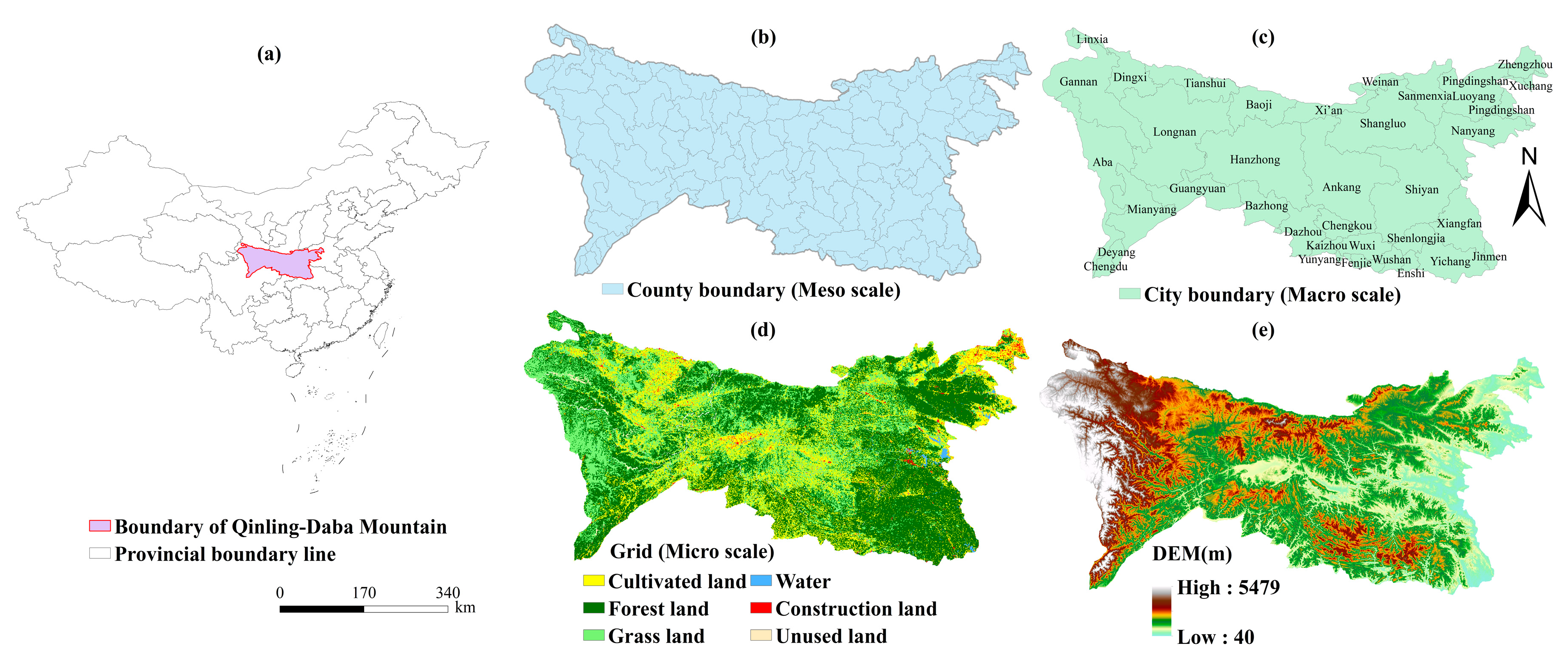
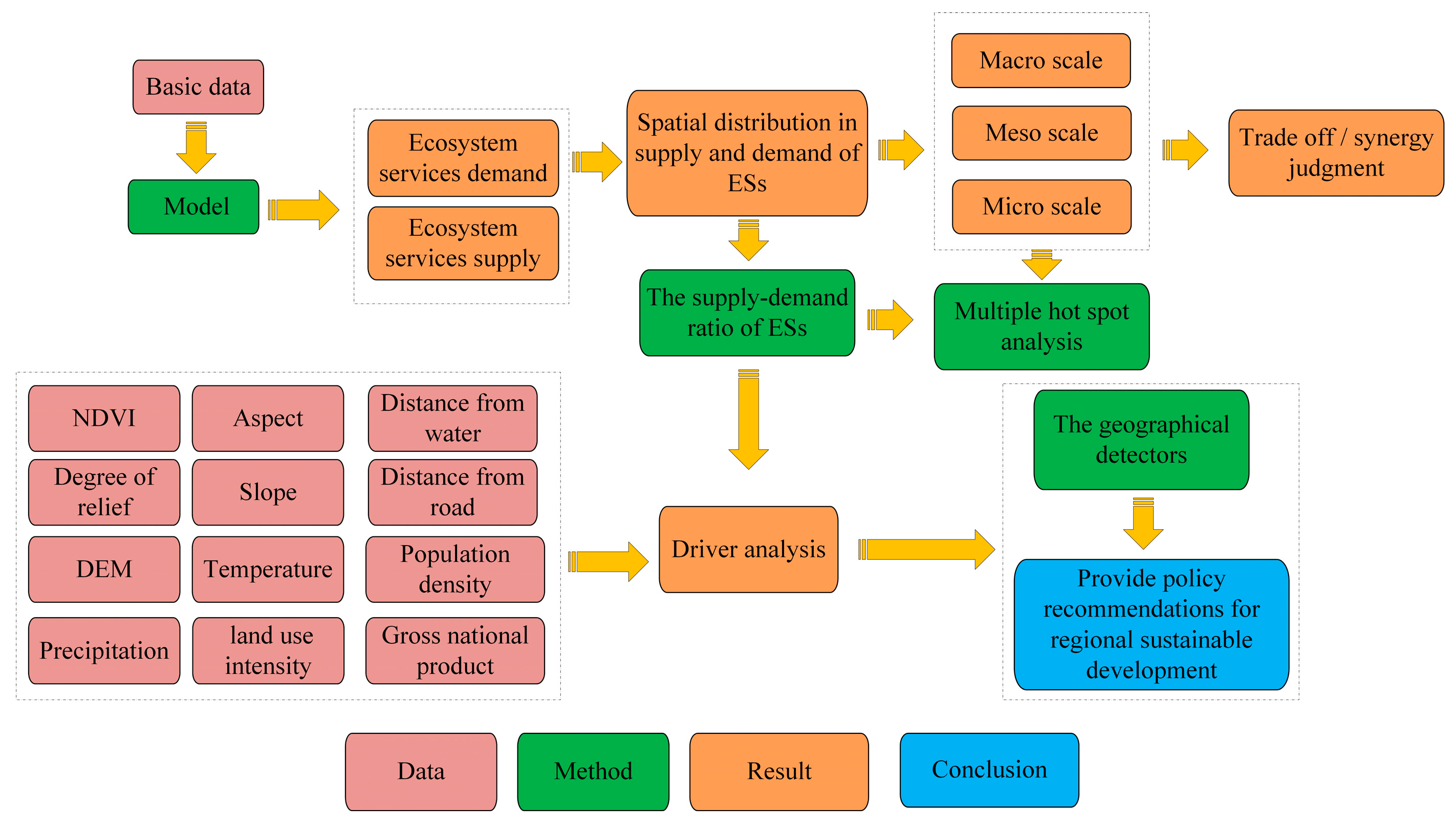

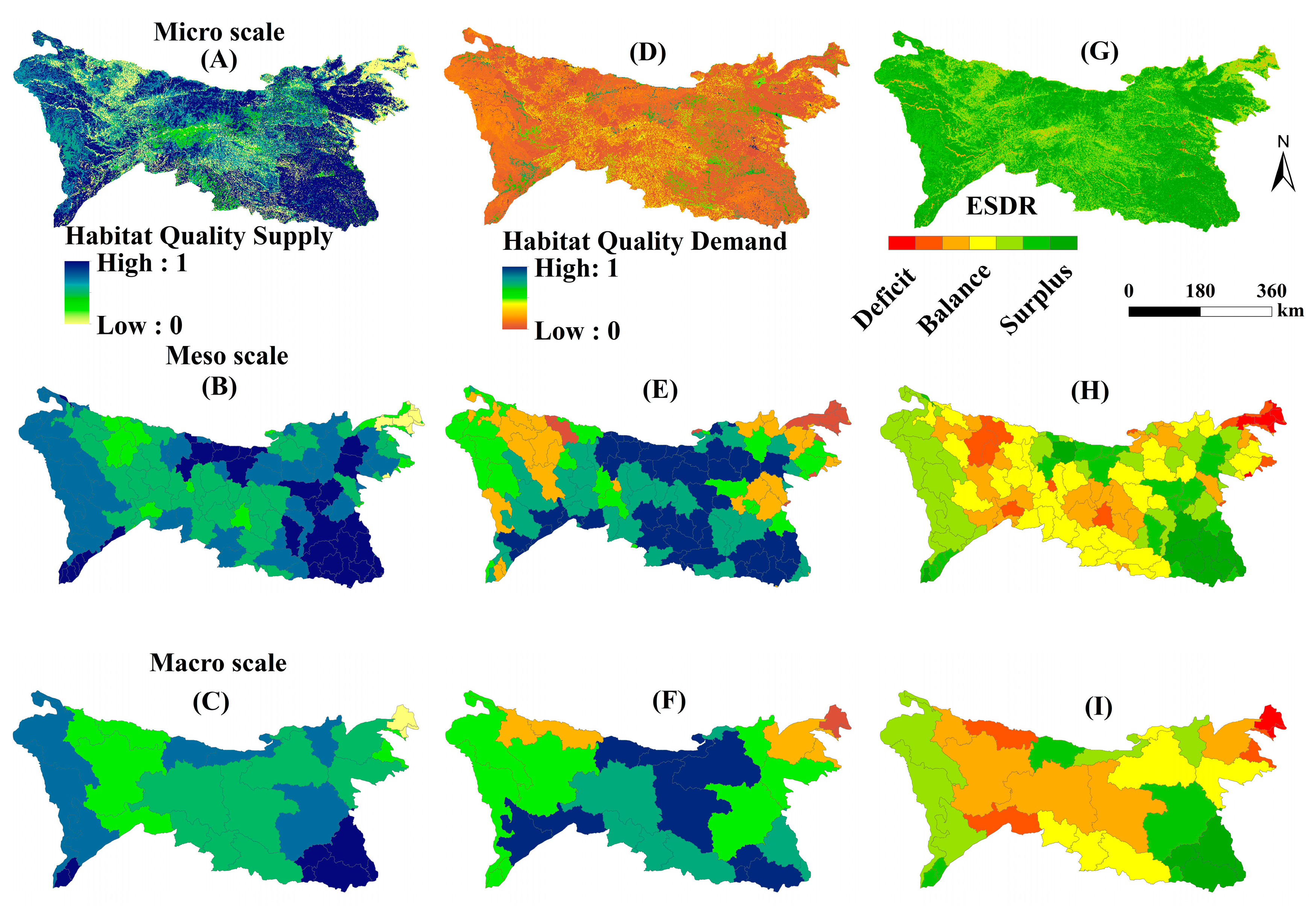
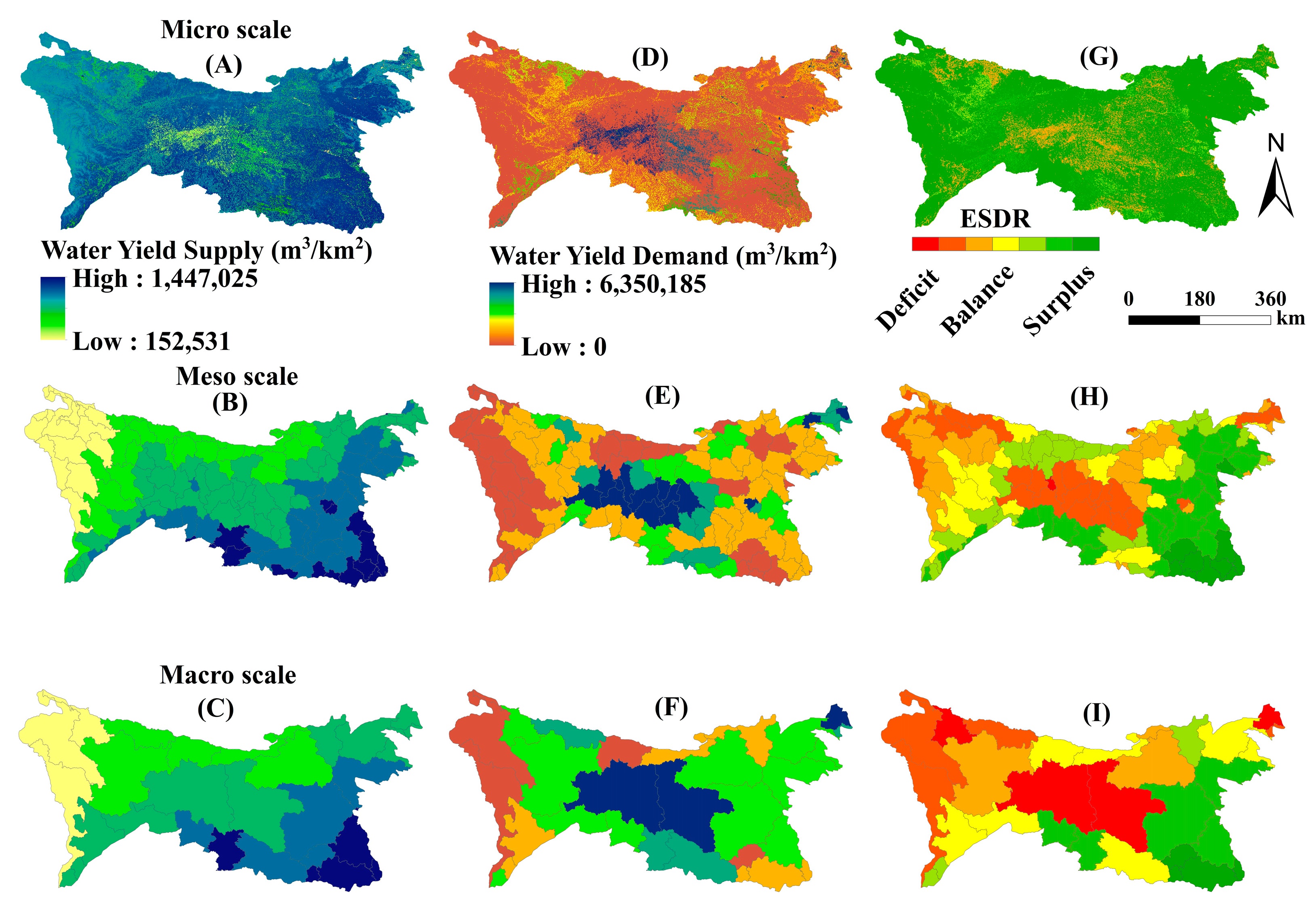
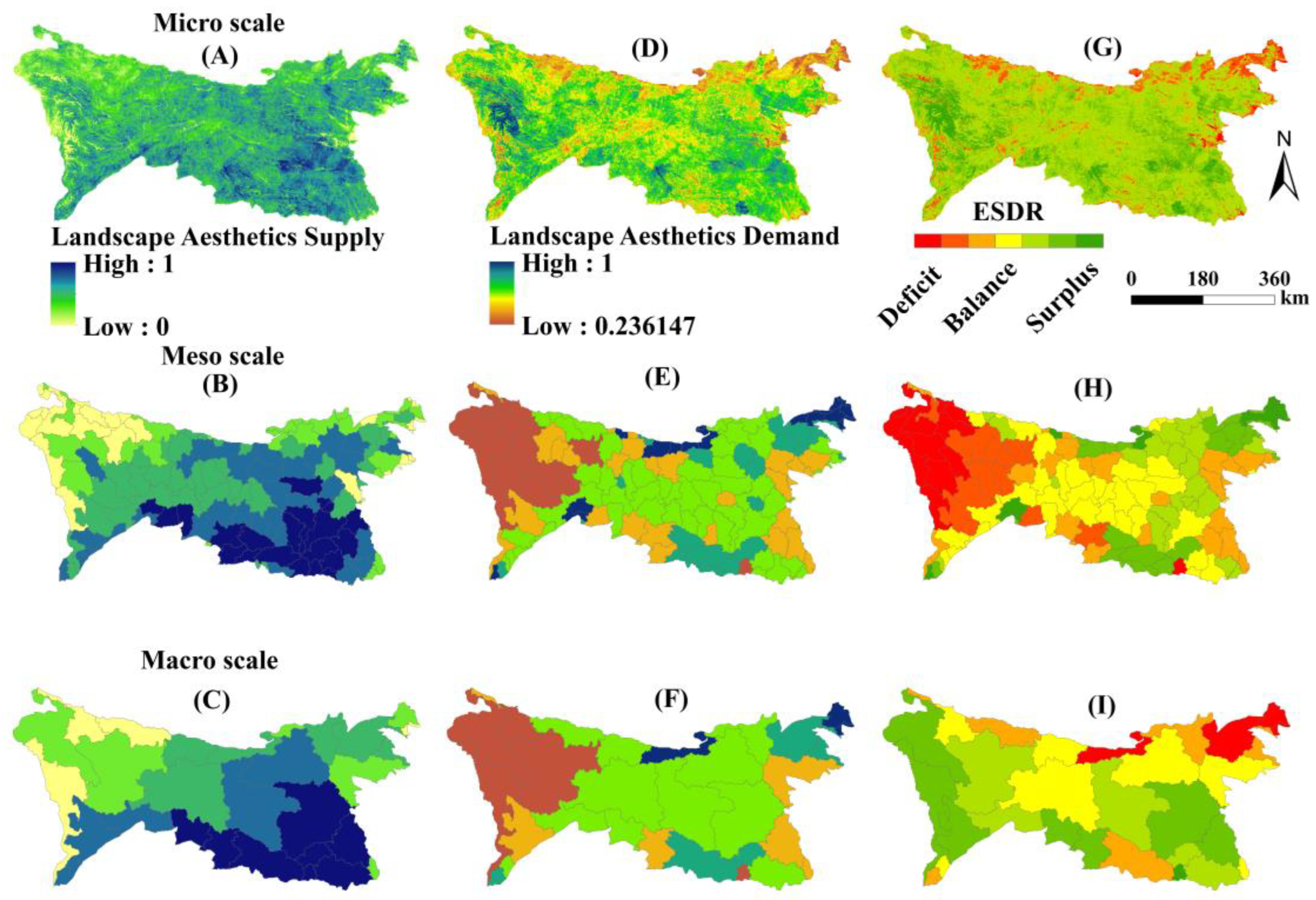
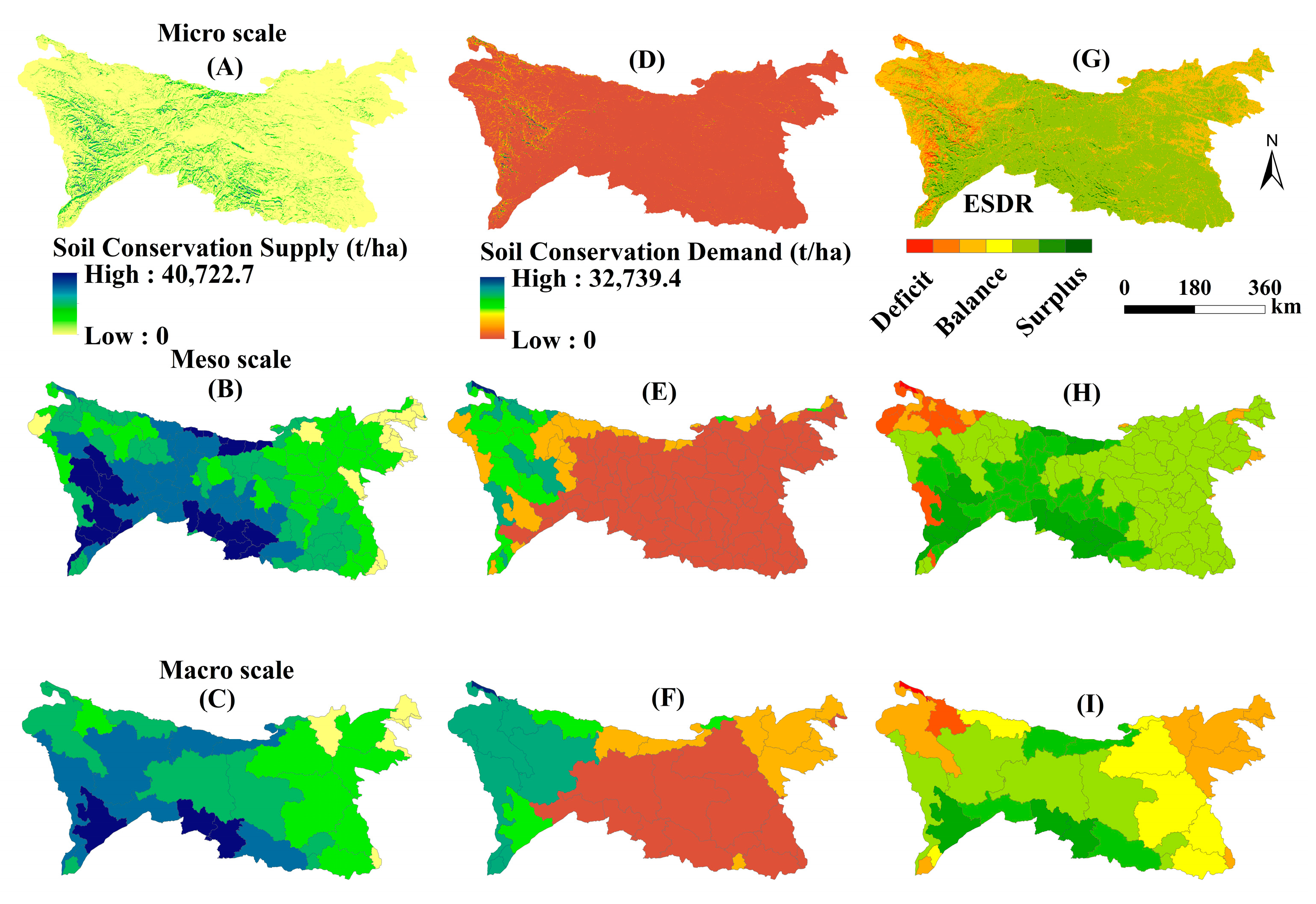

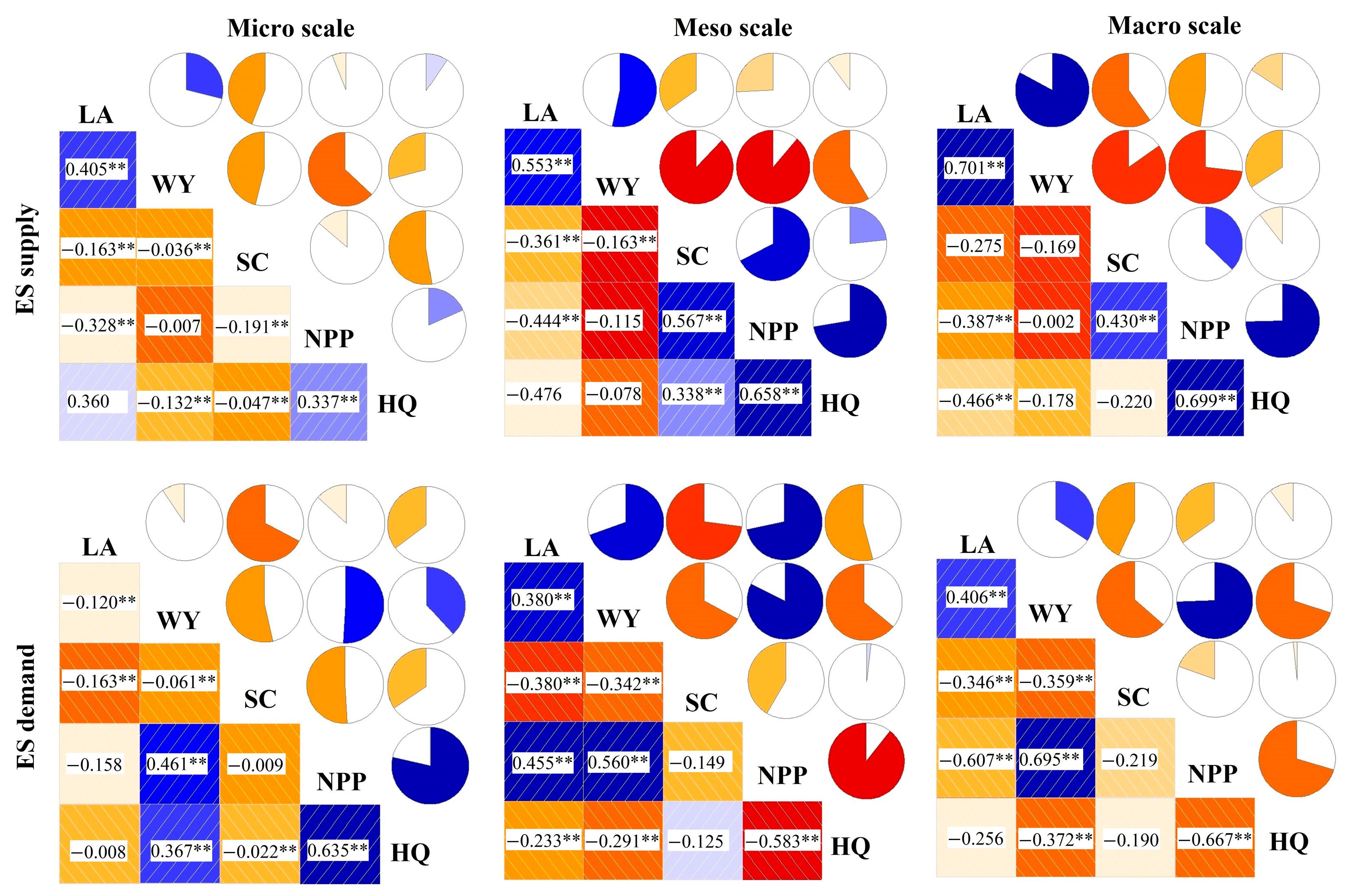
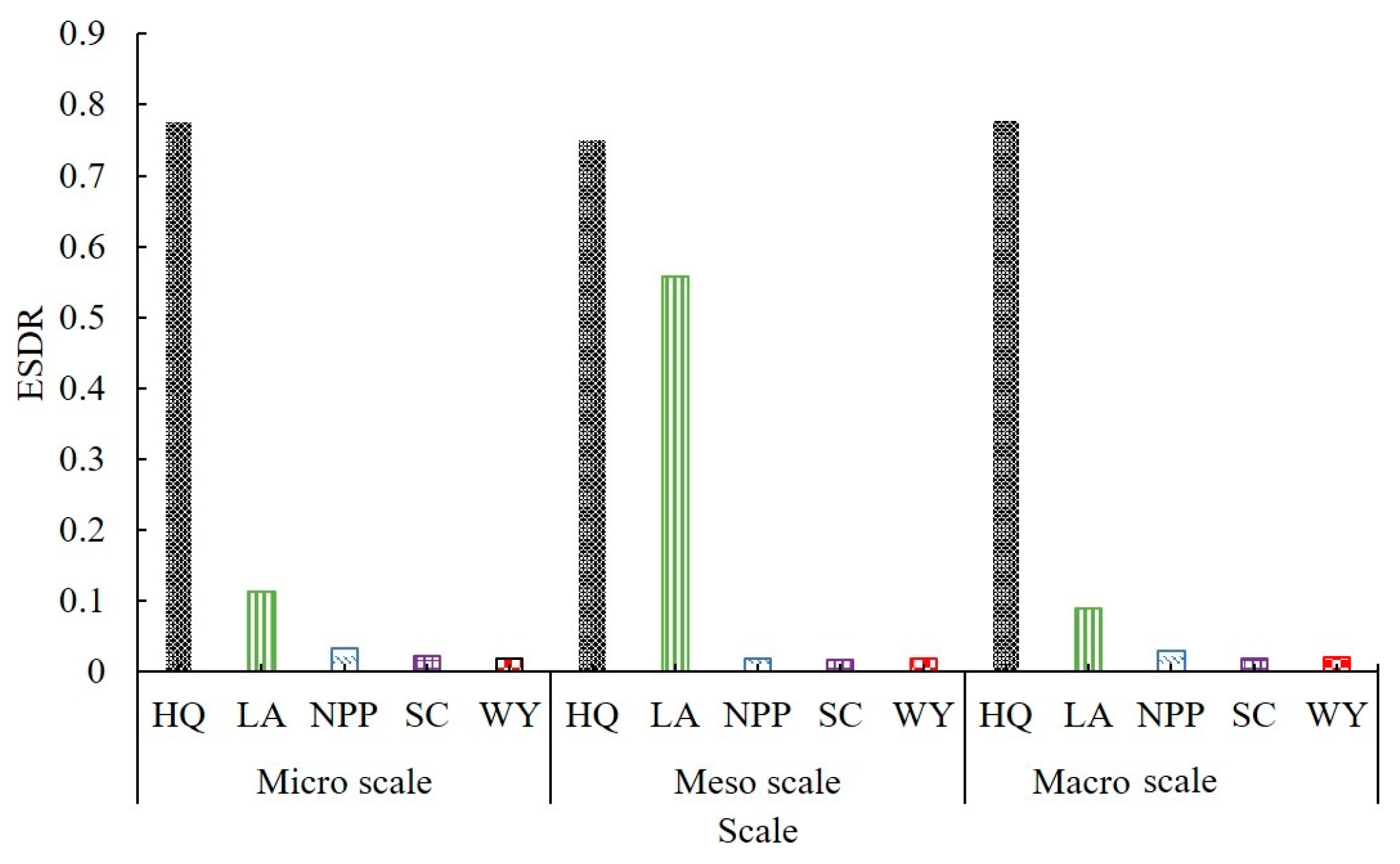
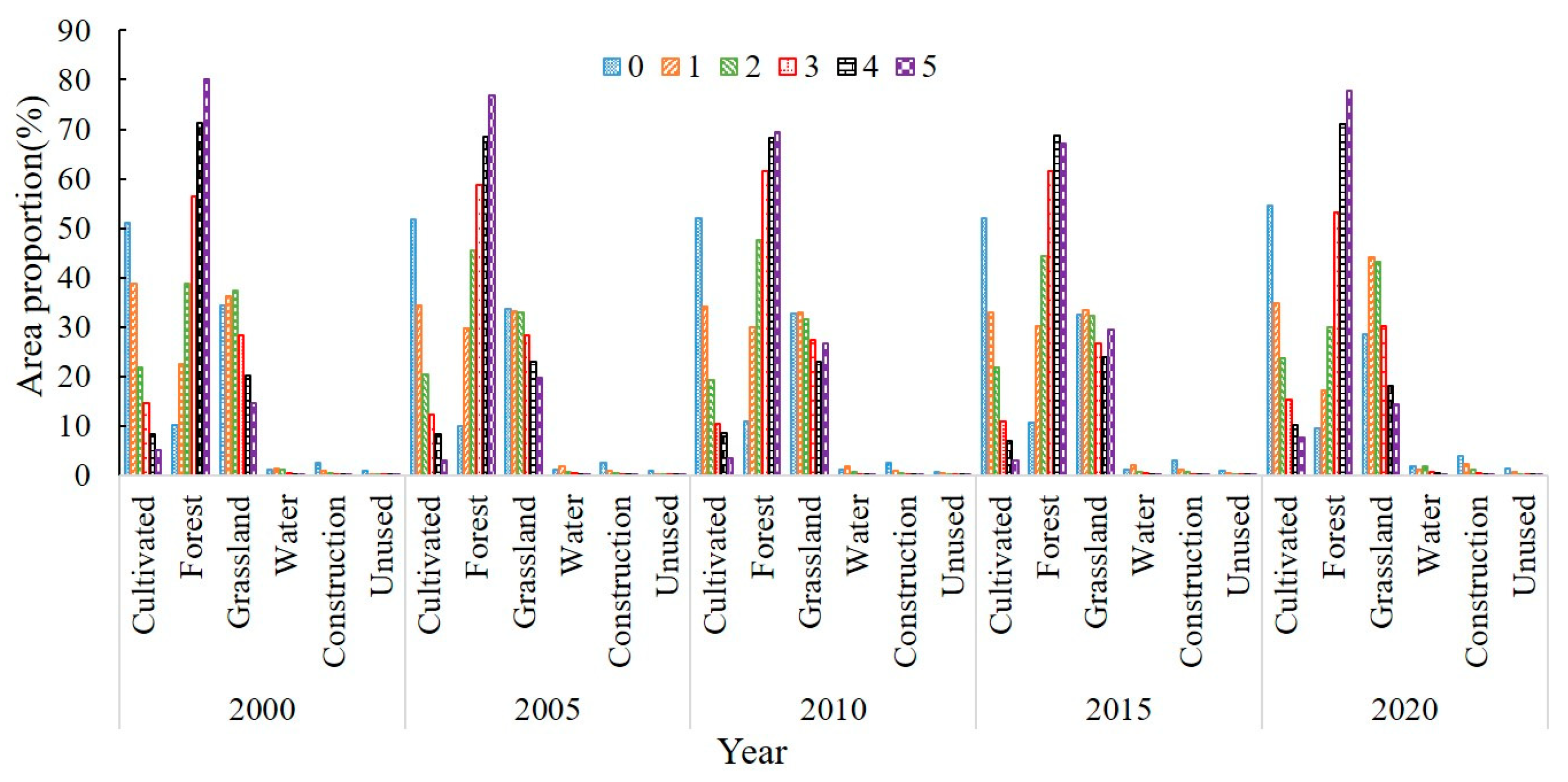


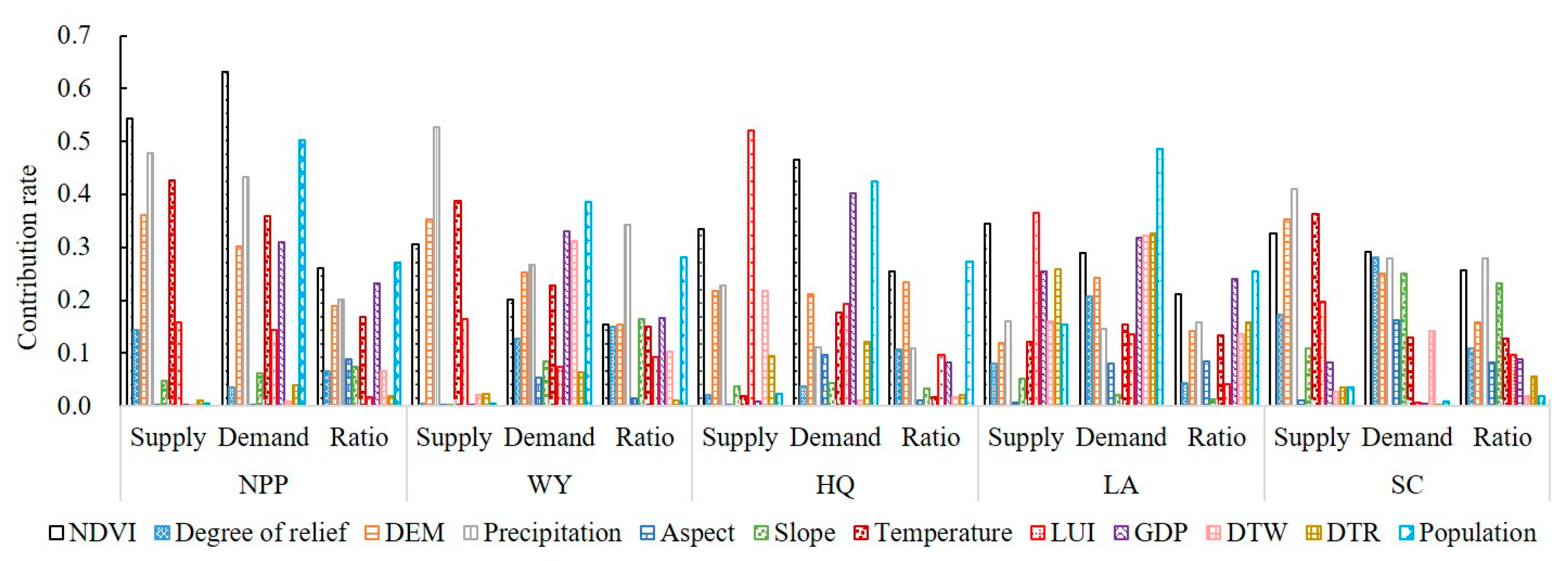
| Data Type | Data Description | Data Source |
|---|---|---|
| Basic geographic information data | Administrative divisions, rivers, roads, etc. | http://www.ngcc.cn/ngcc/ Accesses 15 May 2018 |
| Normalized difference vegetation index, NDVI data | 250 m spatial resolution MOD13Q1 data, which was obtained from NASA from 2000 to 2020. | https://ladsweb.modaps.eosdis.nasa.gov/ Accesses 20 January 2021 |
| Soil data | 1:1 million soil data provided by Nanjing Soil Institute of the Second National Land Survey, with a spatial resolution of 1 km × 1 km | https://data.tpdc.ac.cn/zh-hans/ Accesses 5 April 2018 |
| Land use data | Sourced from GlobalLand30, a global geographic information public product with a spatial resolution of 30 m, from 2000 to 2020 | http://www.globallandcover.com/ Accesses 1 March 2021 |
| Meteorological data | Spatially interpolated dataset of average conditions of meteorological elements in China with a spatial resolution of 1 km, from 2000 to 2020. | http://www.resdc.cn/ Accesses 18 March 2021 |
| Socio-economic data (GDP, population density, energy consumption, urban and rural water consumption, etc.) | Socio-economic data, energy consumption, water utilization, and tourism numbers and revenues were almost exclusively derived from 2000 to 2020 statistical yearbooks. | http://www.stats.gov.cn/ Accesses 20 December 2021 |
| Service Category | ES Assessment | Code | Unit | Description | Supply Quantification Method | Demand Quantification Method | References |
|---|---|---|---|---|---|---|---|
| Provisioning | Water yield | WY | m3/km2 | Estimated water yield per pixel based on hydrological processes such as precipitation and evapotranspiration | Water yield module of Integrated Valuation of Ecosystem Services and Trade-offs (InVEST) | The sum of residential water, industrial water, and farmland irrigation | [32,33] |
| Maintenance | Habitat quality | HQ | Probability | Ability of the ecosystem to provide appropriate conditions for individual and population persistence. | Habitat quality module of InVEST | The product of per capita consumption and population density of habitat quality | [34] |
| Cultural | Landscape aesthetics | LA | Scores | Potential visual appeal is controlled by inherent landscape characteristics such as topography or vegetation. | Visual quality index (VQI) | The logarithmic function of the number of tourists per unit area is used as the demand for landscape aesthetics | [35,36] |
| Regulating | Soil conservation | SC | t/ha | Amount of sediment that vegetation preserved under water erosion during rainfall events. | Revised universal soil loss equation (RULSE) | Actual soil conservation | [37,38,39,40,41] |
| Net primary productivity | NPP | t/km2 | Amount of carbon that is sequestered from plants and soil. | Carnegie–Ames–Stanford approach (CASA) | Product of per capita carbon consumption and population density | [42,43,44] |
| WY and NPP | HQ and NPP | LA and NPP | SC and NPP | WY and HQ | WY and LA | SC and WY | LA and HQ | SC and HQ | SC and LA | |
|---|---|---|---|---|---|---|---|---|---|---|
| NDVI | 0.357 | 0.417 | 0.460 | 0.526 | 0.451 | 0.362 | 0.276 | 0.399 | 0.401 | 0.548 |
| Degree of relief | 0.143 | 0.207 | 0.139 | 0.173 | 0.113 | 0.112 | 0.383 | 0.130 | 0.096 | 0.030 |
| DEM | 0.309 | 0.386 | 0.423 | 0.393 | 0.307 | 0.101 | 0.232 | 0.428 | 0.294 | 0.281 |
| Precipitation | 0.461 | 0.374 | 0.254 | 0.411 | 0.498 | 0.436 | 0.414 | 0.327 | 0.380 | 0.371 |
| Aspect | 0.090 | 0.196 | 0.080 | 0.010 | 0.020 | 0.094 | 0.147 | 0.024 | 0.157 | 0.013 |
| Slope | 0.034 | 0.098 | 0.095 | 0.029 | 0.034 | 0.160 | 0.346 | 0.067 | 0.144 | 0.116 |
| Temperature | 0.242 | 0.250 | 0.351 | 0.363 | 0.377 | 0.218 | 0.379 | 0.417 | 0.260 | 0.239 |
| LUI | 0.141 | 0.168 | 0.101 | 0.197 | 0.079 | 0.168 | 0.144 | 0.129 | 0.135 | 0.031 |
| GDP | 0.014 | 0.005 | 0.030 | 0.083 | 0.076 | 0.046 | 0.015 | 0.012 | 0.013 | 0.065 |
| DTW | 0.021 | 0.003 | 0.101 | 0.026 | 0.218 | 0.232 | 0.198 | 0.160 | 0.027 | 0.132 |
| DTR | 0.023 | 0.010 | 0.240 | 0.034 | 0.094 | 0.233 | 0.017 | 0.259 | 0.006 | 0.174 |
| Population | 0.028 | 0.021 | 0.101 | 0.035 | 0.017 | 0.078 | 0.073 | 0.089 | 0.012 | 0.012 |
Disclaimer/Publisher’s Note: The statements, opinions and data contained in all publications are solely those of the individual author(s) and contributor(s) and not of MDPI and/or the editor(s). MDPI and/or the editor(s) disclaim responsibility for any injury to people or property resulting from any ideas, methods, instructions or products referred to in the content. |
© 2023 by the authors. Licensee MDPI, Basel, Switzerland. This article is an open access article distributed under the terms and conditions of the Creative Commons Attribution (CC BY) license (https://creativecommons.org/licenses/by/4.0/).
Share and Cite
Yu, Y.; Wang, Y.; Li, J.; Han, L.; Zhang, S. Optimizing Management of the Qinling–Daba Mountain Area Based on Multi-Scale Ecosystem Service Supply and Demand. Land 2023, 12, 1744. https://doi.org/10.3390/land12091744
Yu Y, Wang Y, Li J, Han L, Zhang S. Optimizing Management of the Qinling–Daba Mountain Area Based on Multi-Scale Ecosystem Service Supply and Demand. Land. 2023; 12(9):1744. https://doi.org/10.3390/land12091744
Chicago/Turabian StyleYu, Yuyang, Yunqiu Wang, Jing Li, Liqin Han, and Shijie Zhang. 2023. "Optimizing Management of the Qinling–Daba Mountain Area Based on Multi-Scale Ecosystem Service Supply and Demand" Land 12, no. 9: 1744. https://doi.org/10.3390/land12091744
APA StyleYu, Y., Wang, Y., Li, J., Han, L., & Zhang, S. (2023). Optimizing Management of the Qinling–Daba Mountain Area Based on Multi-Scale Ecosystem Service Supply and Demand. Land, 12(9), 1744. https://doi.org/10.3390/land12091744






